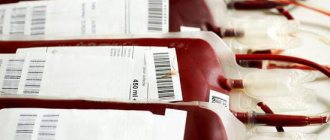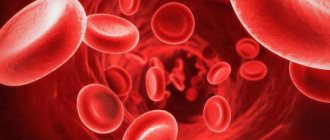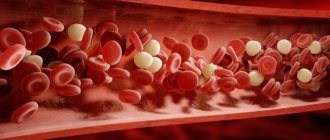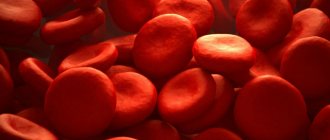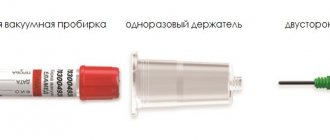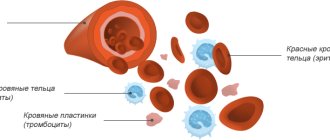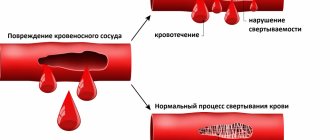Pulmonary hemorrhage: types, treatment
We are talking about a dangerous complication of various pathologies of the respiratory system, which is accompanied by the leakage of blood from the vessels located in the bronchi or lungs and its release.
Characteristic manifestations of the syndrome:
- Cough, which produces blood, liquid scarlet or in the form of clots;
- State of weakness;
- State of dizziness;
- Reduced blood pressure;
- Fainting state.
In order to identify the cause of the syndrome, various diagnostic methods are used, for example, radiography, tomography, bronchoscopy, etc.
To stop the syndrome, various treatment methods are used, including conservative hemostatic therapy and surgical treatment.
The syndrome is typical for lung oncology, as it occurs in half of patients.
The intensity of the syndrome varies: its severity is estimated from 600 ml to more than a liter of blood loss per day.
Kinds
It is important to see the difference between the two concepts “pulmonary hemorrhage” and “hemoptysis”. The latter is less dangerous, it is characterized by a lower volume and rate of blood release, but it can often precede bleeding. Therefore, the importance of its treatment is undeniable.
The classification, which has been used since 1990, distinguishes three degrees of bleeding:
- The first stage is daily blood loss from 50 to 100 ml;
- The second stage is daily blood loss from 100 to 500 ml;
- The third stage is daily blood loss of more than 500 ml.
The condition of heavy bleeding, which occurs simultaneously or over a short period, is extremely dangerous. So, in a severe form of the syndrome, the immediate blood loss can be more than 100 ml.
The difference between “hemoptysis” and “pulmonary hemorrhage” is also important because the first does not frighten the oncologist, he simply makes adjustments to the treatment, while the second requires urgent help, often resuscitation.
National Society for the Study of Atherosclerosis
The concept of pulmonary embolism
Pulmonary embolism (PE) is a sudden cessation of blood flow in a branch of the pulmonary artery due to blockage by a blood clot (thrombus), resulting in a cessation of blood flow to the area of the lung tissue supplied by this branch.
It should be clarified that the mentioned thrombus is a fragment of another thrombus formed and located outside the pulmonary artery. The condition in which blood clots spread through the vessels of the body is called thromboembolism. To be able to exist, the human body needs oxygen, and the supply of oxygen to the body must be continuous. To do this, gas exchange constantly occurs in the lungs. With the branches of the pulmonary artery, venous blood used by the body is delivered to the smallest formations of lung tissue, called alveoli. Here this blood is freed from carbon dioxide, which is removed from the body during exhalation, and is saturated with oxygen from the atmospheric air entering the lungs during inhalation. As a result of gas exchange, the blood becomes arterial. This blood then enters the pulmonary veins and then into the left chambers of the heart. From the left ventricle, blood is delivered through the branches of the largest artery in the body, called the aorta, to all organs and tissues of the body. In tissues, arteries divide into the smallest vessels (capillaries), which subsequently give rise to veins. Gradually, the caliber of the veins increases, they gather into large superior and inferior vena cava, through which the outflow of venous blood into the right chambers of the heart occurs. From the right ventricle, venous blood again enters the pulmonary artery. It should be noted that after leaving the heart, the trunk of the pulmonary artery is divided into the right and left pulmonary arteries, one for each of the lungs. These arteries, in turn, are divided into branches according to the number of lobes and segments in each of the lungs. With the development of pulmonary embolism, blood circulation in that segment of the lung tissue suffers, in the branch of the pulmonary artery of which thromboembolism occurred. It should be mentioned that the delivery of oxygen and nutrients to the pulmonary tissue is carried out by the bronchial branches of the thoracic aorta, and not by the pulmonary artery [1].
Causes of pulmonary embolism
The immediate cause of PE is a blood clot that has migrated into the pulmonary artery from the place in the body where it formed. Such blood clots are called emboli. Most often, blood clots migrate from the deep veins of the legs in the segment: thigh - pelvic region (iliofemoral segment) - with the so-called ileofemoral (iliofemoral) thrombosis [4, 6]. The formation of a blood clot in a vein (venous thrombosis) occurs as a result of various reasons, for example, increased blood clotting (hypercoagulation), diseases of the leg veins, and the installation of various catheters into the leg veins during surgical procedures. The occurrence of thrombosis in the iliofemoral region is facilitated by limited mobility, for example, during long air travel, forced long-term bed rest in the postoperative period, etc. PE ends in about 50% of cases of ileofemoral thrombosis [6]. In addition to the iliofemoral segment, thrombi from the deep veins of the leg, as well as from the veins of the arms, can become a source of embolism5. As a result of gynecological diseases, as well as operations associated with them, the deep veins of the pelvic region can become a source of thromboembolism. A number of heart diseases: cardiomyopathies, atrial fibrillation with thrombus formation in the right atrium and others can also be complicated by the development of pulmonary embolism. With infective endocarditis of the right chambers of the heart, pulmonary embolism of microbial origin is possible. According to American researchers, 300,000 patients with pulmonary embolism are admitted to hospitals in the United States every year [6].
Development of pulmonary embolism
The changes that occur in the body during pulmonary embolism are determined by the following factors [4, 6, 9]:
- size and number of emboli. Large blood clots usually block blood flow in large branches of the pulmonary artery. Thromboembolism with multiple emboli increases the likelihood of multiple pulmonary embolisms. According to statistics, with pulmonary embolism both lungs are affected in 65% of cases, the right lung in 20%, and the left lung in only 10% of cases [9];
- severity and level of blood flow disturbance in the pulmonary artery. There is a direct relationship: the closer to the beginning of the branch of the pulmonary artery the blockage occurs, the more pronounced the disorders associated with pulmonary embolism;
- the initial state of the patient's circulatory and respiratory organs.
In some patients with a number of diseases of the heart and lungs, at the time of pulmonary embolism there is thickening of the wall (hypertrophy) of the right ventricle. Such a hypertrophied right ventricle better resists a sharp increase in pressure in the pulmonary artery caused by thromboembolism. On the other hand, the presence of chronic diseases of the lungs and bronchi can contribute to an even greater increase in pressure in the pulmonary artery during thromboembolism. To overcome the obstruction to blood flow that has arisen in the form of an embolus, the pressure in the pulmonary artery begins to rise sharply. The situation is aggravated by the emerging reflex in the form of an involuntary contraction (spasm) of the pulmonary artery in response to an existing obstacle, as well as various biochemical reactions that develop with the participation of components of the blood clot. As a result, increased pressure begins to affect the functioning of the right ventricle. The higher the pressure in the pulmonary artery, the more pronounced the overload the right ventricle experiences.
In practically healthy individuals in this situation, the right ventricle usually cannot cope with such an overload and its contractile (pumping) function sharply decreases, so-called acute right ventricular failure occurs. In patients with initial hypertrophy of the right ventricle, its failure, as a rule, develops only in the case of very severe PE. The development of pulmonary embolism is accompanied by an increase in the frequency of respiratory movements (hyperventilation occurs), which is a consequence of a chain of complex reflex reactions occurring in the body during pulmonary embolism. Ventilation of segments of the lungs into which blood has stopped flowing as a result of pulmonary embolism is maintained, although gas exchange no longer occurs in them. Perhaps, in order to avoid such ventilation, which is useless for the body, after some time such segments of the lung tissue collapse (“deflate”). A collapsed area of lung tissue is called atelectasis. In addition, the formation of atelectasis is facilitated by the cessation of the production of surfactant - a substance due to which the alveoli of the lung tissue, in which gas exchange directly occurs, normally never collapse. The presence of atelectasis leads to a decrease in arterial blood oxygen saturation, i.e. hypoxemia occurs.
In approximately 10% of cases of pulmonary embolism, pulmonary infarction develops, which is a blood-soaked thickening of the lung tissue [9]. In most cases, such lung tissue subsequently dies and is replaced by so-called connective tissue, in which ventilation and gas exchange are impossible. Pulmonary infarction usually develops in patients with pre-existing chronic diseases of the bronchi and lungs, as well as in a number of heart diseases occurring with left ventricular failure, in particular with mitral stenosis. Left ventricular failure causes circulatory disorders in many organs and tissues, including lung tissue. In most of the remaining patients who have undergone pulmonary embolism, the emboli completely dissolve (lyse) within approximately two weeks. This occurs as a result of complex processes in which the so-called anticoagulant blood system takes an active part. In a minority of patients, the blood clots thicken and blood flow through the pulmonary artery is restored. Due to the fact that the blood supply to the lung tissue is carried out from the bronchial branches of the thoracic aorta, the lung tissue in the atelectasis zone does not die. Over time, blood flow in this zone is completely restored, the production of surfactant is resumed, and the collapsed areas of the lungs are straightened out.
Complaints of patients with pulmonary embolism
Manifestations of the disease and related complaints are determined by the severity of pulmonary embolism, the initial condition of the patient, as well as the presence of pulmonary infarction [4, 6, 9]. With embolism of small branches of the pulmonary artery, the disease may not manifest itself in any way. In other cases of pulmonary embolism, which are not complicated by the development of pulmonary infarction, patients note a lack of air and unexplained shortness of breath. Very often these complaints are accompanied by increased breathing and the appearance of anxiety. A sharp increase in pressure in the pulmonary artery leads to a deterioration in the blood supply to the heart muscle (myocardium) of the right ventricle. It is believed that pain or discomfort (discomfort) in the middle of the chest (behind the sternum) is associated with this disorder. In the case of the development of acute right ventricular failure, swelling of the neck veins and a decrease in blood pressure (BP) are observed, which can cause a deterioration in blood supply to the brain with the appearance of dizziness, headaches and fainting. In a number of patients, pulmonary embolism is manifested by repeated disturbances in heart rhythm (arrhythmias). In patients with pre-existing respiratory and circulatory diseases, their exacerbation is noted (the cough intensifies, suffocation appears, etc.). When a large area of the lungs is “turned off,” the skin acquires a bluish tint (cyanosis), which is the result of a decrease in blood oxygen saturation. With the development of a pulmonary infarction, in addition to shortness of breath, pain in the chest usually appears, mainly during inspiration. This is due to irritation of the lining of the lungs (pleura), which is densely permeated with nerve formations. Hemoptysis or the presence of streaks of blood in the sputum due to damage to the lung tissue is one of the characteristic signs of pulmonary infarction. Both as a result of a heart attack and as a result of pneumonia (pneumonia) developing around the heart attack area, there is an increase in body temperature, usually not higher than 38? C.
Diagnosis of pulmonary embolism
Considering that PE can be accompanied by shortness of breath and other manifestations that occur in various diseases of the heart and lungs, the presence of PE cannot always be suspected. In addition, most existing diagnostic methods also do not detect PE [4, 6, 9]. Electrocardiographic (ECG) examination in a few cases reveals signs of right ventricular overload. An X-ray examination of the chest organs is the most informative in case of pulmonary infarction, since it allows one to identify characteristic foci (foci) in the lungs. With pulmonary embolism without pulmonary infarction, a so-called weakening of the vascular pattern (i.e., the contours of the pulmonary artery) in the affected area may be observed. There may also be dilatation of the contours of the large veins of the chest as a result of a deficiency in the pumping function of the right ventricle. In some cases, an experienced radiologist may see a branch of the pulmonary artery that is “broken” due to a blockage. It should be clarified that the presence of atelectasis of the lung tissue is not a sign typical only for PE. With massive pulmonary embolism, studying the blood gas composition helps to establish a decrease in blood oxygen saturation and other abnormalities.
Perfusion and ventilation scanning of the lungs are radioisotope research methods that make it more likely to establish the presence of pulmonary embolism. During these studies, radioactively labeled substances are injected into the body. Subsequently, these substances accumulate in the lungs for some time, which makes it possible to evaluate their function. Perfusion scanning is needed to identify defects in the blood supply to the lung tissue. The presence of such defects makes the diagnosis of pulmonary embolism probable, but exactly the same findings can occur in other lung diseases, for example, cancer. A ventilation scan is necessary to identify areas of the lungs with impaired ventilation. Diagnoses of pulmonary embolism and pulmonary infarction are confirmed if defects in the blood supply to the lung tissue with unimpaired ventilation are detected. In unclear cases of pulmonary embolism, the diagnosis can be made after some time (retrospectively). To do this, the results of repeated ECGs, chest x-rays and lung scans must be evaluated, i.e. in dynamics. Angiopulmonography is an X-ray surgical method for diagnosing pulmonary embolism, which has maximum information content. Pulmonary angiography is performed in controversial cases. The method involves injecting a contrast agent directly into the pulmonary artery. Technically, this is carried out under local anesthesia: a large vein of the leg, arm or neck is punctured (pierced), then a special catheter tube is passed through the right atrium and right ventricle of the heart into the pulmonary artery. A contrast agent is then injected and x-rays of the area being examined are taken. The diagnosis of pulmonary embolism is characterized by a sudden “break” of a branch of the pulmonary artery and identification of the outlines of a blood clot in it. An additional argument in favor of the diagnosis of pulmonary embolism is the detection of thrombosis of the leg veins in the patient based on the results of their ultrasound examination (duplex scanning).
Treatment of pulmonary embolism
Cases of minor pulmonary embolism sometimes go unnoticed by the patient and doctors, and self-healing is observed. When treating diagnosed cases of pulmonary embolism, bed rest is prescribed and oxygen inhalation is performed. Painkillers are prescribed as an auxiliary treatment for chest pain. To increase the function of the right ventricle and dilate the bronchi, so-called β-adrenergic agonists, for example, the drug isoproterinol, can be used. With a pronounced decrease in blood pressure, a constant intravenous drip of drugs is established that increases the pumping function of the heart and increases blood pressure, for example, dopamine or dobutamine. With a confirmed diagnosis of PE, the primary treatment tactics depend on its massiveness, right ventricular function and blood pressure level [6, 9]. With massive pulmonary embolism, right ventricular failure and the level of systolic (“upper”) blood pressure? 90 mmHg So-called thrombolytics are prescribed once - drugs that dissolve blood clots, for example, streptokinase or urokinase. When using thrombolytics, bleeding throughout the body may occur. Therefore, treatment with thrombolytics is not carried out after a recent stroke (cerebral infarction), during pregnancy, recent and current exacerbations of gastric and duodenal ulcers, etc.
The use of thrombolytics should be carried out under the control of indicators of the so-called blood coagulation system. In proven cases of pulmonary embolism of the medium or small branches of the pulmonary artery, mild right ventricular failure and normal blood pressure levels, treatment is carried out with anticoagulants - drugs that reduce the activity of the blood coagulation system. The fast-acting drug heparin is prescribed intravenously and then subcutaneously. Its administration is continued for 7-10 days. 5 days before discontinuation of heparin, anticoagulants are prescribed in tablets, for example, warfarin, which is treated for an average of 6 months. Long-term treatment with anticoagulants is necessary to reduce the risk of recurrent pulmonary embolism and to eliminate thrombosis of the leg veins. Control measures and the likelihood of side effects are the same as when using thrombolytics. Surgical removal of the embolus (embolectomy) is necessary in cases of rapidly developing massive pulmonary embolism with the threat of death. Embolectomy is also performed in patients with massive pulmonary embolism, for whom thrombolytics and anticoagulants are contraindicated for various reasons.
Prevention of pulmonary embolism
First of all, to prevent PE, it is necessary to treat thrombosis of the veins of the legs (or other likely sources of PE). For this purpose, anticoagulants are prescribed, sometimes for life. In cases of repeated pulmonary embolism and the inability to eliminate venous thrombosis, as well as to prevent the possibility of massive pulmonary embolism in the future, a special valve is installed in the inferior vena cava to prevent the spread of blood clots. Most often, such valves (traps) take the form of an open umbrella, mesh or canister and are called vena cava filters. Technically, the vena cava filter is installed below the level of the renal arteries by puncture (puncture) of a large vein of the leg. An alternative to installing a vena cava filter to retain thrombus fragments is the artificial creation of narrow channels in the lumen of the inferior vena cava (cavaplication). Among general preventive measures, I would like to note the need to avoid prolonged immobility and lying down. For this purpose, for example, after various surgical interventions in hospitals, physical therapy classes are conducted, starting from the early postoperative period. When patients are completely immobile due to various reasons, prophylactic administration of anticoagulants is necessary. For varicose veins of the lower extremities, elastic stockings can be useful to prevent blood clots.
Causes
The causes of the syndrome are often associated with cancer - tumors of the bronchi and lungs. Sometimes the cause is secondary damage to the bronchi and lungs by metastases from other organs.
The cause of bleeding in oncology is a vessel corroded by atypical cells. The tumor disrupts the normal functioning of the vascular wall of the bronchi, it becomes inelastic and blood begins to flow out of it. That is, there is a connection between the size of the vessel defect and the intensity of bleeding.
Most of the bleeding occurs in the first stage of the syndrome. If lightning bleeding occurs, it is extremely difficult to save a person: two thirds of patients die within the first hour if help is not provided.
Lung vessels
The pulmonary trunk (truncus pulmonalis) with a diameter of 30 mm emerges from the right ventricle of the heart, from which it is delimited by its valve. The beginning of the pulmonary trunk and, accordingly, its opening are projected onto the anterior chest wall above the place of attachment of the cartilage of the third left rib to the sternum. The pulmonary trunk is located anterior to the remaining large vessels of the base of the heart (aorta and superior vena cava). To the right and behind it is the ascending aorta, and to the left is the left ear of the heart. The pulmonary trunk, located in the pericardial cavity, is directed in front of the aorta to the left and posteriorly and at the level of the IV thoracic vertebra (cartilage of the II left rib) is divided into the right and left pulmonary arteries. This place is called the bifurcation of the pulmonary trunk (bifurcatio tninci pulmonalis). Between the bifurcation of the pulmonary trunk and the aortic arch there is a short arterial ligament (ligamentum arteriosum), which is an overgrown arterial duct (ductus arteriosus).
The right pulmonary artery (a.pulmonalis dextra) with a diameter of 21 mm follows to the right to the gate of the right lung behind the ascending aorta and the terminal section of the superior vena cava and anterior to the right bronchus. In the region of the right lung hilum, in front of and under the right main bronchus, the right pulmonary artery divides into three lobar branches. Each lobar branch in the corresponding lobe of the lung is in turn divided into segmental branches. In the upper lobe of the right lung, there is an apical branch (r.apicalis), posterior descending and ascending branches (rr.posteriores descendens et ascendens), anterior descending and ascending branches (rr.anteriores descendens et ascendens), which follow into the apical, posterior and anterior segments of the right lung.
The branch of the middle lobe (rr.lobi medii) is divided into two branches - lateral and medial (r.lateralis et r.medialis).
These branches go to the lateral and medial segments of the middle lobe of the right lung. The branches of the lower lobe (rr.lobi inferioris) include the upper (apical) branch of the lower lobe [r.superior (apicalis) lobi inferioris], heading to the apical (upper) segment of the lower lobe of the right lung, as well as the basal part (pars basalis). The latter is divided into 4 branches: medial, anterior, lateral and posterior (rr.basales medialis, anterior, lateralis et posterior). They carry blood to the basal segments of the same name in the lower lobe of the right lung.
The left pulmonary artery (a.pulmonalis sinistra) is shorter and thinner than the right, passes from the bifurcation of the pulmonary trunk along the shortest path to the gate of the left lung in the transverse direction in front of the descending aorta and left bronchus. On its way, the artery crosses the left main bronchus, and at the hilum of the lung is located above it. According to the two lobes of the left lung, the pulmonary artery is divided into two branches. One of them breaks up into segmental branches within the upper lobe, the second - the basal part - with its branches supplies blood to the segments of the lower lobe of the left lung.
The branches of the upper lobe (rr.lobi superioris) are sent to the segments of the upper , which give off the apical branch (r.apicalis), anterior ascending and descending (rr.anteriores ascendens et descendens), posterior ( r.posterior) and lingual r .lingularis) branches. The superior branch of the lower lobe (r.superior lobi inferioris), as in the right lung, follows into the lower lobe of the left lung, to its upper segment. The second lobar branch - the basal part (pars basalis) is divided into four basal segmental branches: medial, lateral, anterior and posterior (rr.basales medialis, lateralis, anterior et posterior), which branch in the corresponding basal segments of the lower lobe of the left lung.
In the lung tissue (under the pleura and in the area of the respiratory bronchioles), small branches of the pulmonary artery and bronchial branches extending from the thoracic aorta form systems of interarterial anastomoses. These anastomoses are the only place in the vascular system in which blood can move along a short path from the systemic circulation directly to the pulmonary circulation.
The figure shows the arteries corresponding to the segments of the lungs.
Right lung
Upper lobe
- apical (S1);
- rear (S2);
- anterior (S3).
Average share
- lateral (S4);
- medial (S5).
Lower lobe
- upper (S6)
- ;mediobasal (S7);
- anterobasal (S8);
- lateralobasal (S9);
- posterobasal (S10).
Left lung
Upper lobe
- apical-posterior (S1+2);
- anterior (S3);
- upper reed (S4);
- lower reed (S5).
Lower lobe
- upper (S6);
- anterobasal (S8);
- lateralobasal, or laterobasal (S9);
- posterobasal (S10).
PULMONARY VEINS
Venules begin from the capillaries of the lung, which merge into larger veins and form two pulmonary veins in each lung.
Of the two right pulmonary veins, the upper one has the larger diameter, since blood flows through it from the two lobes of the right lung (upper and middle). Of the two left pulmonary veins, the inferior vein has the larger diameter. At the gates of the right and left lungs, the pulmonary veins occupy their lower part. In the posterior upper part of the root of the right lung is the main right bronchus, anterior and inferior to it is the right pulmonary artery.
- LVLV - left superior pulmonary vein
- RSPV - right superior pulmonary vein
- ILV - inferior pulmonary vein
- RPA - right pulmonary artery
- LPA - left pulmonary artery
At the top of the left lung is the pulmonary artery, posterior and inferior to it is the left main bronchus. In the right lung, the pulmonary veins lie below the artery, follow almost horizontally and on their way to the heart are located behind the superior vena cava, the right atrium and the ascending aorta. Both left pulmonary veins, which are somewhat shorter than the right ones, are located under the left main bronchus and are also directed to the heart in the transverse direction, anterior to the descending aorta. The right and left pulmonary veins, perforating the pericardium, flow into the left atrium (their terminal sections are covered with the epicardium).
Symptoms
Medical practice shows that the syndrome is usually preceded by a severe cough. At first it is dry, then mucous sputum and blood admixtures are observed. As we have already said, the blood can be scarlet or in the form of clots.
In some cases, the precursors of the syndrome are:
- A tickling or gurgling sensation in the throat;
- Burning in the chest.
The general condition of the patient largely depends on how the blood loss is expressed. It could be:
- Fright;
- State of sudden loss of strength;
- Pallor;
- Sweating;
- Reduced blood pressure;
- Cardiopalmus;
- Feeling dizzy;
- Shortness of breath, etc.
If the syndrome is classified as profuse, the following may occur:
Coughing up bloody mucus
- State of fainting;
- Vomit;
- Convulsive state;
- Visual impairment;
- Asphyxia.
Ekaterina Misheneva: “Don’t let the blood stagnate”
Today in Russia, mortality from cardiovascular diseases directly related to thrombosis is twice the European average and amounts to more than 1.5 thousand people per hundred thousand population. Ekaterina Misheneva, a cardiologist at the State Institution of the Republic of Kazakhstan "Cardiological Dispensary", spoke in an interview with Respublika about what kind of disease this is and who is susceptible to it.
– So what is thrombosis?
– Thrombosis is a blockage of a vessel with a blood clot, while blood does not enter the organ, and it may suffer. Most often, a person's limbs are affected. In the body of a healthy person, the formation of such a clot helps stop bleeding. For example, if you cut yourself or have your blood taken for a test, the bleeding will stop after a while. But sometimes it also happens that thrombosis occurs when it should not exist, that is, for no apparent reason. Sometimes this causes myocardial infarction (a blood clot in the arteries that supply the heart muscle) or a stroke (a blood clot in the arteries of the brain). And this can threaten not only health, but also life. Such thrombosis can also occur due to certain characteristics of genes, i.e. hereditary information recorded in the cells of your body. Therefore, if a person wants to connect his life with a profession that involves high-risk situations, for example, working as a rescuer, police officer, or in professional sports, he should undergo a molecular genetic examination. Problems begin when blood clots, attaching to the walls of blood vessels, form a plug, which at any moment can break off, set sail through the veins and arteries and, once in a bottleneck, completely block the blood flow. And the man suddenly dies. Everyone is afraid of plane crashes, but few people know that after a safe landing you can collapse dead right on the plane's ramp - due to a blood clot that has formed in the veins during the flight. It is believed that blood clots form in one of the passengers on every flight. Fortunately, not every case ends in tragedy. According to statistics, 70 percent of people experience thrombosis.
– Why do blood clots occur? Can the danger be identified? And how to protect yourself from the threat?
- Let's figure out why blood clots occur in the veins. For blood clots to form, a combination of three factors is necessary. The first factor is damage to the inner surface of blood vessels (occurs after traumatic, tumor or inflammatory diseases). The second is a slowdown in blood flow (occurs with heart failure, prolonged bed rest and varicose veins). And the third is increased blood clotting (noted during injuries, inflammatory processes, surgical interventions and dehydration). Sometimes one reason is enough. If all three are present, thrombus formation is inevitable. There are two types of thrombosis - venous and arterial. Venous is more common. It is dangerous for its complications, the most severe of which is thromboembolism (blockage of branches) of the pulmonary artery. Surgeons claim that this diagnosis explains a third of cases of sudden death. More than half of patients die in the first two hours after the onset of embolism. Arterial blood clots are less common, but they are more insidious. Being in fast blood flow, they more often come off, first causing disruption of the blood supply to the organ that the artery supplies with blood, and then its death. Thus, thrombosis of the coronary arteries leads to myocardial infarction, and of the cerebral arteries - to a stroke. Veins are quite delicate and easily wounded anatomical formations. Their walls are much thinner than those of arteries of the same diameter. Blood pressure in the veins is much lower, so the middle (muscular) layer is less developed. Veins are less resistant to external compression and injury; they are easily involved in the inflammatory process even without the participation of microorganisms. In addition, the veins have valves, damage to which and stagnation of blood in the area where they are located contribute to the formation of blood clots. Maintaining blood in a liquid state is ensured by the simultaneous operation of a huge number of complex biochemical mechanisms. They maintain a precise balance between the coagulation and anticoagulation systems of the blood. There are a large number of typical situations, well known to doctors, in which venous blood flow is simultaneously disrupted and the coagulation system is activated. For example, during any surgical operation, a large amount of tissue thromboplastin, a substance that stimulates blood clotting, enters the bloodstream from the tissues. The more severe and extensive the operation, the greater the release of this substance. The same thing happens with any injury. This mechanism was formed in ancient times, and without it humanity as a biological species simply would not have survived. Otherwise, any injury to our distant ancestors, and to us, would have ended in death from bleeding. The body as an integral system is indifferent to what caused the wound - the claws of a saber-toothed tiger or a surgeon's scalpel. In any case, the blood clotting potential is rapidly activated. But this protective mechanism can often play a negative role, since it creates the preconditions for the formation of blood clots in the venous system in operated patients.
– It is clear that any operation is a risk.
– On the first day after surgery, it is difficult for the patient to get up, move and walk. This means that the work of the muscular-venous pump is turned off and venous blood flow slows down. In case of injuries, in addition, it is necessary to apply plaster casts, skeletal traction, and connect bone fragments with metal pins, which sharply limits the patient’s physical activity and contributes to the occurrence of thrombosis. Its incidence after surgical operations on the abdominal organs can reach 25-40 percent. With hip fractures, knee and hip replacements, thrombosis in the deep veins of the legs develops in 60-70 percent of patients. The most serious problem is venous thromboembolic complications during pregnancy. The fact is that a woman’s body itself prepares in advance for childbirth, and therefore for blood loss. Already from the early stages of pregnancy, the blood coagulation system is activated. The inferior vena cava and iliac veins are compressed by the growing uterus. Consequently, the risk of thrombosis increases. Acute venous thrombosis may complicate the use of hormonal contraceptives. These drugs seem to deceive the woman’s body, “convincing” it that pregnancy has already occurred, and hemostasis naturally reacts by activating the coagulation system. Although pharmacologists try to reduce the hormone content, primarily estrogens, in these drugs, the incidence of venous thrombosis (and therefore the possibility of pulmonary embolism) in women taking hormonal contraceptives is at least 3-4 times higher than in those taking hormonal contraceptives. who doesn't accept them. The risk of blood clots is especially high in women who smoke, since nicotine releases thromboxane, a powerful blood clotting factor. Excess weight also actively promotes thrombus formation. Venous thrombosis is a common complication of neoplasms, both malignant and benign. Patients with tumors usually have increased blood clotting. This is apparently due to the fact that the patient’s body prepares in advance for the future disintegration of the growing tumor. Often, venous thrombosis acts as the first clinical sign of the onset of a cancer process. Even a long flight in a cramped airplane seat, with legs bent at the knees, and forced inactivity, can provoke vein thrombosis, the so-called “economy class syndrome.” Thus, any surgical intervention, any injury, pregnancy, childbirth, any disease associated with the patient’s immobility, circulatory failure, can be complicated by venous thrombosis and pulmonary embolism. This is precisely what explains such a high incidence of venous thromboembolic complications, even in countries with well-developed medicine.
– How to determine thrombosis by external signs? And who is more susceptible to this disease?
– The insidiousness of venous thrombosis also lies in the fact that its clinical manifestations do not cause the patient a feeling of great distress. Swelling of the leg, pain, usually of a moderate nature, and slight cyanosis of the limb do not frighten patients, and sometimes they do not even consider it necessary to see a doctor. In this case, without any warning, a blood clot can break away from the vein wall in a few seconds, turn into an embolus - a blood clot that migrates through the vessels, and cause severe thromboembolism of the pulmonary arteries with an unpredictable outcome. According to experts, about 100,000 people die annually from pulmonary embolism in the Russian Federation. Thus, this disease claims more lives than car accidents, regional conflicts and criminal incidents combined. Due to its transience and unpredictability, pulmonary embolism is perceived as a bolt from the blue not only by patients, but also by doctors. Fortunately, not every venous thrombosis is complicated by thromboembolism, although their number is very high. Blood clots are more often found in older people. Physical inactivity that accompanies a sedentary lifestyle provokes blood stasis - one of the main risk factors for the disease. One of the common causes of arterial thrombosis is atherosclerosis. Atherosclerotic plaques cause narrowing of the arteries. Blood flow becomes difficult, and favorable conditions arise for the formation of thrombosis. The relationship between smoking and the formation of atherosclerosis, and therefore the occurrence of blood clots, has been proven. But most often people who have a tendency to form blood clots - thrombophilia - are at risk of thrombosis. It can be genetic, associated with gene damage, and be inherited. And in some cases it may be caused by an imbalance of the coagulation and anticoagulation systems.
– Blood clots often form in the summer, why?
– There are several reasons for this. The main thing is travel, or rather, the air travel that accompanies it. Air passengers sit for a long time in uncomfortable positions, veins are pinched, and low pressure and extremely dry air in airplane cabins contribute to blood stagnation and rapid dehydration of the body. To avoid blood clots, before the flight you need to tighten compression hosiery (it improves blood flow in the legs), take a quarter of an aspirin tablet, which reduces blood viscosity. And during the flight, stretch your legs more often: try to get up and walk around the cabin after the plane has gained altitude, every 30 minutes. The second reason is the summer desire to lose weight. Blood clots are more likely to form in women who are on diets (removing excess fluid from the body is the basis of diets, and this is where dehydration of the body begins) or taking birth control pills (they increase blood clotting).
– Is it possible to sense the lurking danger?
– Symptoms of venous thrombosis are heaviness in the muscles (usually the calf muscles), swelling of only one lower limb, hardening along the veins, bluish skin, pain. If venous thrombosis is complicated by thromboembolism in the pulmonary arteries, then in addition to swelling and pain in one of the extremities, pain in the chest, aggravated by breathing, cough, hemoptysis, and increased body temperature are added. Often such patients are treated by a neurologist diagnosed with intercostal neuralgia or by a therapist diagnosed with pneumonia. Sometimes such “minor” embolism may not manifest itself at all until repeated episodes lead to more severe changes in pulmonary blood flow. Signs of arterial thrombosis depend on where the blood clot is located. With arterial blood clots in the arms or legs, patients complain of sharp pain, coldness in this limb and loss of sensitivity. If it is the arm, then it is often difficult to measure blood pressure or impossible to measure it at all. Blood clots in the abdominal arteries cause vomiting, diarrhea, and abdominal pain. Thrombosis of the cerebral arteries can manifest as a stroke. Blood clots in the coronary arteries - myocardial infarction - severe pressing or burning pain in the chest. However, about 30 percent of venous thrombosis may be asymptomatic. They are the most dangerous. To detect them, you need to undergo examinations. As a rule, routinely detected blood clots are not removed, but dissolved with special preparations.
– How are thromboses treated?
– The fight against deadly thromboembolism of the pulmonary arteries is primarily a fight against acute venous thrombosis. Of course, it is much more effective to prevent thrombosis than to treat it. That is why the problem of preventing venous thromboembolic complications is now attracting the attention of doctors of various specialties. This is why surgeons, oncologists, gynecologists, physical therapy doctors so persistently try to get their patients out of bed the next day after surgery, or even on the same day, in order to take a few steps around the ward (often hearing accusations from their patients of all the deadly sins ). By the way, the common phrase “movement is life” comes to mind in this case. If thrombosis of the main veins has already developed, then doctors direct all efforts primarily to preventing pulmonary embolism. Previous attempts to remove the thrombus completely turned out to be futile, since against the background of altered hemostasis, a new thrombus appears on the inflamed vein wall, more friable and even more dangerous. Venous thrombosis does not threaten the vitality of the leg, since the arteries that pass through the blood flow regularly bring oxygen and nutrients. Venous gangrene is a very rare complication; it develops if blood clots close absolutely all veins, both deep and subcutaneous. Therefore, simultaneously with antithrombotic or anticoagulant therapy aimed at preventing the growth and spread of a blood clot, the patient is examined to identify floating, embolic forms of venous thrombosis. For a long time, only phlebography was used for this, that is, x-ray examination of the main veins using a contrast agent. Currently, most patients can be diagnosed using ultrasound techniques. First of all, this is an ultrasound examination of the veins, which does not require puncture of the veins, the introduction of a toxic contrast agent and, which is very important, especially when examining pregnant women, is not associated with irradiation of the patient. At the same time, the information content of the study is not inferior to phlebography. But the most dangerous, often catastrophic course of the situation occurs when a pulmonary embolism has already occurred. Thromboemboli are usually large in size, and in most patients they close the pulmonary trunk or main pulmonary arteries.
– So how to protect yourself from blood clots?
– First of all, lead an active lifestyle - physical activity improves blood circulation, prevents blood stagnation, and improves metabolic processes in the body. It is necessary to eat properly - the basis of the diet should be plant foods that do not contain cholesterol. The body should not be dehydrated—lack of fluid increases blood viscosity. Take care of yourself: injuries, operations, infectious diseases are a risk factor for blood clots. Get tested on time. Ultrasound duplex scanning of veins, during which the diameter of the vein is measured and the speed of blood flow is determined. Often the blood clot itself can be seen on ultrasound. Donate blood for cholesterol, undergo a coagulogram (blood clotting test). Get a blood chemistry test (a high level of an indicator called D-dimer is a key indicator of thrombosis, but can be elevated in other diseases). In-depth studies for thrombophilia are quite expensive to do for anyone concerned about their health, but we still recommend them when one of the relatives (father, mother, brothers, sisters, uncles, aunts, grandmothers, grandfathers) have had thrombosis in the family or thromboembolism, as well as cases of sudden death of relatives under the age of 55 years. Or in case of thrombosis in a person under the age of 50 years. We also recommend it in case of causeless recurrence of thrombosis of any location. These examinations are necessary to determine a more accurate treatment method. Modern medicine has a wide range of tools for diagnosing and treating acute venous thrombosis and pulmonary embolism. Nevertheless, it should be remembered that the best way to combat this most dangerous complication is prevention, carried out in collaboration between the doctor and the patient. The fight against excess weight, uncontrolled use of hormonal drugs, smoking, physical inactivity, conscious and active implementation of medical recommendations can significantly reduce the frequency of tragedies and misfortunes caused by this disease.
Diagnostics
To determine the syndrome, an examination by an ENT specialist is necessary. That is, it is necessary to understand the nature of the bleeding, because its causes can be not only the lungs, but also the mucous membrane and the stomach.
Main types of diagnostic tests:
- X-ray;
- Computed tomography using contrast.
If it is impossible to find the source of bleeding, bronchoscopy is performed. The method can also be used as a therapeutic method, especially when there is a threat to the patient’s life.
Angiography is another diagnostic method. It is often resorted to when the syndrome is minor and its source has been identified.
Pulmonary embolism
Diagnosis of pulmonary embolism
Clinical manifestations of pulmonary emboli depend on the location of emboli, the degree of pulmonary blood flow impairment and concomitant diseases. Clinical signs, although not specific, give reason to suspect the disease and roughly judge the location of the lesion. With embolism of the distal branches of the pulmonary arteries, most patients develop symptoms of infarction pneumonia: sharp “pleural” chest pain associated with breathing, shortness of breath, cough with scanty sputum, fever. Hemoptysis is observed only in 1/3 of cases. An objective examination reveals moist rales and pleural friction noise. It should be taken into account, firstly, that in 60% of patients, infarction pneumonia does not develop (and then there are no symptoms), and secondly, it takes 2-3 days after the embolism for the formation of a heart attack. In the presence of concomitant pathology of the cardiovascular system, distal embolism can manifest itself as collapse and symptoms of right ventricular failure. With massive pulmonary emboli, emboli are localized in the pulmonary trunk or main pulmonary arteries. It usually manifests itself with symptoms of acute cardiopulmonary failure: collapse, severe shortness of breath, tachycardia, chest pain. If more than 60% of the arterial bed of the lungs is excluded from the blood circulation, an enlarged liver and swelling of the neck veins appear. If PE is suspected, the following studies are required: - electrocardiography - echocardiography - chest radiography - perfusion (perfusion-ventilation) lung scintigraphy or spiral computed tomography or angiopulmonography - ultrasound examination of the main veins of the legs.
On the ECG, the most typical signs are the appearance of Q in lead III, deep S in lead I and negative T in lead III (McGinn-White syndrome), as well as right bundle branch block. Negative symmetrical T waves may appear in leads V1-3(4); ST elevation in III, aVF, aVR and V1-3(4); displacement of the transition zone to the left chest leads. Only a third of patients show signs of right heart overload on the ECG. In 20% of patients with pulmonary embolism, there are no changes on the ECG.
An x-ray can reveal dilation of the superior vena cava, enlargement of the right heart, bulging of the conus of the pulmonary artery, high standing of the dome of the diaphragm on the affected side, disc-shaped atelectasis, pleural effusion - however, all these symptoms are not very specific. The only characteristic of PE is the Westermarck symptom: expansion of the root of the lung and depletion of the pulmonary pattern in the affected area, but it is observed only in 5% of cases. However, X-ray data are important for excluding pneumonia, pneumothorax, myocardial infarction, and pericarditis.
Echocardiography can confirm the diagnosis of PE and differentiate it from other acute heart diseases. An echocardiogram reveals hypokinesia and dilatation of the right ventricle; paradoxical movement of the interventricular septum; tricuspid regurgitation; absence or reduction of respiratory collapse of the inferior vena cava; pulmonary artery dilatation; signs of pulmonary hypertension.
Scintigraphy is informative in 87% of cases. It demonstrates perfusion defects of embolic origin - with a clear delineation, triangular shape and location corresponding to the blood supply zone of the affected vessel (lobe, segment). When small branches of the pulmonary artery are occluded, the diagnostic value decreases.
Multislice CT with vascular contrast allows visualization of blood clots in the pulmonary artery, as well as changes in the lungs caused by other diseases manifested by perfusion or filling defects. The sensitivity of this method is high when emboli are localized in large pulmonary arteries and is significantly reduced when subsegmental and smaller arteries are affected.
Pulmonary angiography is recognized as the “gold standard” in the diagnosis of pulmonary embolism. Signs of embolism in this study are: amputation of a vessel or a filling defect in its lumen. A laboratory method for determining D-dimer is used to exclude PE. Its normal plasma level allows us to reject with 90% accuracy the assumption of the presence of pulmonary embolism in patients with low or moderate clinical probability. The diagnosis of pulmonary embolism is established by analyzing the results of clinical, instrumental and laboratory studies. However, during life the diagnosis is correctly established only in 34% of patients. At the same time, in 9% of cases it is overdiagnosed.
Treatment
In the treatment of the syndrome, therapeutic methods, hemostasis, and surgical operations are applicable.
Therapy is prescribed for the syndrome classified as the first two stages.
Aspiration is necessary to remove blood from the tracheal lumen. If we are talking about asphyxia, then urgent intubation, blood suction and artificial ventilation of the lungs are necessary.
Among the medications, hemostatic drugs and antihypertensive drugs are prescribed.
If therapeutic methods do not give a positive result, the syndrome is stopped through local endoscopic hemostasis.
As a rule, these methods help to stop the development of the syndrome for some time.
Palliative surgery is used in cases where it is impossible to perform radical surgery.
As for radical operations, they are aimed at partial resection of the lung, for example, marginal resection or removal of the entire organ.
1.General information
Pulmonary hemorrhage is a highly lethal life-threatening condition that requires medical care under an emergency protocol. Pulmonary hemorrhage differs from hemoptysis (an admixture or streaks of blood in the sputum released during coughing) by significantly larger volumes and, at first, by the bright scarlet color of the blood ejected with coughing (later the blood usually darkens, acquiring a rusty tint).
It should be noted in this regard that the tendency to increase the blood content in the sputum may be a harbinger of “large” bleeding from the main pulmonary vessels into the lumen of the bronchi and further into the oropharynx, which is much more difficult to stop, so any appearance of blood during coughing or expectoration is clearly a reason to urgently seek help.
As a rule, pulmonary hemorrhage occurs in mature and elderly people against the background of severe pulmonary or other somatic diseases. Estimates of mortality in various sources vary widely, since the outcome depends on many factors (timeliness and place of care, nosological and age composition of the statistical sample, etc.). In any case, this is an emergency condition, fatal with a probability of 10 to 60-80 percent.
A must read! Help with treatment and hospitalization!
